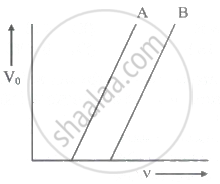Advertisements
Advertisements
प्रश्न
The energy of a photon is 2 eV. Find its frequency and wavelength.
उत्तर
Given:
E = 2 eV = 2 × 1.6 × 10−19 = 3.2 × 10−19 J
To find:
- Frequency (ν)
- Wavelength (λ)
Formulae:
- E = hν
- λ = `c/ν`
Calculation:
i. Using formula (i),
v = `(3.2 xx 10^-19)/(6.63 xx 10^-34)`
= `(3.2 xx 10^15)/6.63`
= antilog {log (3.2) + log(1015) − log(6.63)}
= antilog {0.5051 + 15 − 0.8215}
= antilog {14.6836}
= 4.826 × 1014 Hz
The frequency of photons is 4.826 × 1014 Hz.
ii. Using formula (ii),
`λ = c/ν = (3 xx 10^8)/(4.826 xx 10^14)`
= antilog {log 3 − log 4.826} × 10−6
= antilog {0.4771 − 0.6836} × 10−6
= antilog {`overline1`.7935} × 10−6
= 0.6216 × 10−6m
= 6216 × 10−5 m
= 6216 Å
The wavelength of the photon is 6216 Å.
APPEARS IN
संबंधित प्रश्न
What is the photoelectric effect?
Can microwaves be used in the experiment on photoelectric effect?
As the intensity of incident light increases ______
The maximum kinetic energy of the photoelectrons depends only on ______
State Einstein photoelectric equation. Explain 2 characteristics of the photoelectric effect on the basis of Einstein’s photoelectric equation.
With the help of a circuit diagram describe the experiment to study the characteristics of the photoelectric effect. Hence discuss any 2 characteristics of the photoelectric effect.
The maximum velocity of photoelectron emitted is 4.8 m/s. If the e/m ratio of the electron is 1.76 × 1011 C/kg, then stopping potential is given by ______
Which one of the following is TRUE in photoelectric emission?
The following graph shows the stopping potential V0 versus frequency v for photoelectric emission from two metals A and B. The slope of each of the lines gives ______

When a photon enters glass from air, which one of the following quantity does not change?
When light falls on a metal surface, the maximum kinetic energy of the emitted photoelectrons depends upon ______
If the maximum kinetic energy of emitted electrons in photoelectric effect is 3.2 × 10-19 J and the work-function for metal is 6.63 × 10-19 J, then stopping potential and threshold wavelength respectively are
[Planck's constant, h = 6.63 × 1034 J-s]
[Velocity of light, c = 3 × 108 `"m"/"s"`]
[Charge on electron= 1.6 × 10-19 C]
Threshold frequency for a metal is 1015 Hz. Light of `lambda` = 4000 Å falls on its surface. Which of the following statements is correct?
Threshold wavelength for lithium metal is 6250 Å. For photoemission, the wavelength of the incident light must be ______.
When certain metal surface is illuminated with a light of wavelength A., the stopping potential is V, When the same surface is illuminated by light of wavelength 2λ, the stopping potential is `("V"/3)`. The threshold wavelength for the surface is ______.
Light of frequency 2 times the threshold frequency is incident on a photo sensitive material. If the frequency is made `1/3`rd and intensity is doubled then the photocurrent will ______.
When light of wavelength 'λ' is incident on a photosensitive surface, the stopping potential is 'V'. When light of wavelength '3λ' is incident on the same surface, the stopping potential is `"V"/6`. Threshold wavelength for the surface is _______.
When a surface 1 cm thick is illuminated by light of wavelength 'λ', the stopping potential is 'V0'. When the same surface is illuminated by light of wavelength '3λ', the stopping potential is `"V"_0/6`. The threshold wavelength for the metallic surface is ______.
When a certain metallic surface is illuminated with monochromatic light of wavelength '`lambda`', the stopping potential for photoelectric effect is '3V0'. If the same surface is illuminated with a light of wavelength '`2 lambda`', the stopping potential is found as 'V0'. The threshold wavelength for this surface is ____________.
When a metal with work function 0.6 eV is illuminated with light of energy 2 eV, the stopping potential will be ____________.
In experiment of photoelectric effect, the stopping potential for incident yellow light of wavelength 5890 Å is 4 volt. If the yellow light is replaced by blue light of wavelength 4000 Å, the stopping potential is ____________.
The stopping potential in the context of photoelectric effect depends on the following property of incident electromagnetic radiation ______.
In a photoelectric experiment, ultraviolet light of wavelength 280 nm is used with a lithium cathode having work function Φ = 2.5 eV. If the wavelength of incident light is switched to 400 nm, find out the change in the stopping potential.
(h = 6.63 × 10-34 Js, c = 3 × 108 ms-1)
When radiation of wavelength λ is used to illuminate a metallic surface, the stopping potential is V. When the same surface is illuminated with radiation of wavelength 3λ, the stopping potential is `"V"/4`. If the threshold wavelength for the metallic surface is nλ. then value of n will be ______.
The radiation emitted, when an electron jumps from n = 3 to n = 2 orbit is a hydrogen atom, falls on a metal to produce photoelectron. The electrons from the metal surface with maximum kinetic energy are made to move perpendicular to a magnetic field of `1/320`T in a radius of 10-3m. Find the 320 work function of metal:
For a given photosensitive material and frequency (> threshold frequency) of incident radiation, the photoelectric current varies with the intensity of incident light as:
In a photocell, frequency of incident radiation is increased by keeping other factors constant (v > v0), the stopping potential ______.
Explain the experimental set-up of photoelectric effect.
